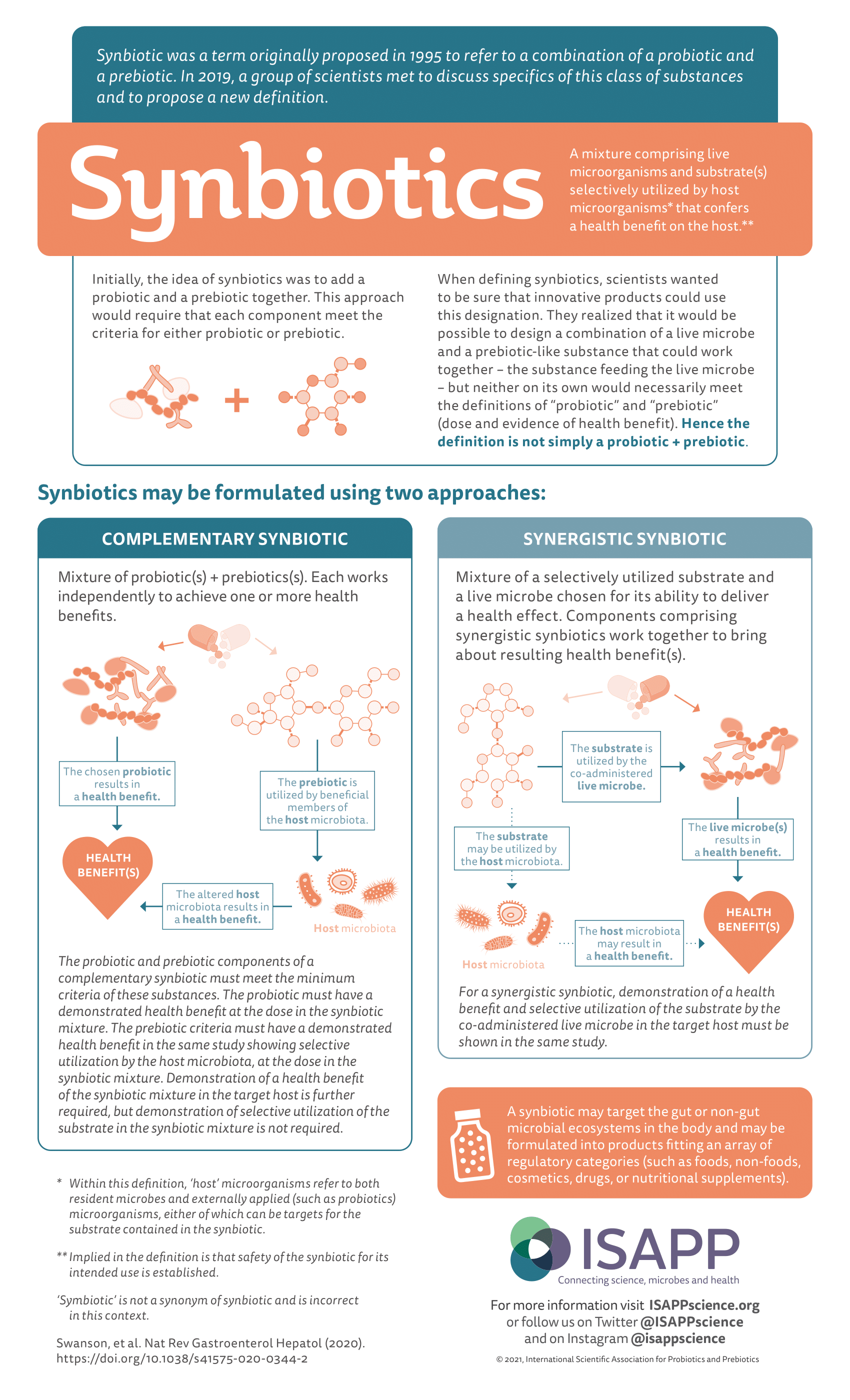New synbiotic definition lays the groundwork for continued scientific progress
By Karen Scott, Mary Ellen Sanders, Kelly Swanson, Glenn Gibson, and Bob Hutkins
When Glenn Gibson and Marcel Roberfroid first introduced the prebiotic concept in 1995, they also conceived that prebiotics could be combined with probiotics to form synbiotics. In 2011, Gibson and Kolida described additional criteria for defining synbiotics and proposed that synbiotics could have either complementary or synergistic activities.
In the past decade, nearly 200 clinical studies on synbiotics have been reported in the literature. Nonetheless, the term itself has been open to interpretation, and the existing definition – a probiotic plus a prebiotic – was inadequate to account for the synbiotic formulations described in the literature or available in the marketplace.
To provide clarity on the definition and lay the groundwork for progress in the years ahead, scientists working on probiotics, prebiotics, and gut health came together in an expert panel. The outcome of this panel, the ISAPP consensus definition and scope of the word synbiotic, has now been published in Nature Reviews Gastroenterology & Hepatology.
A diverse panel of experts
The panel of experts who met to discuss the definition of synbiotics in May, 2019, consisted of eleven interdisciplinary scientists in the fields of microbiology and microbial ecology, gastrointestinal physiology, immunology, food science, nutritional biochemistry, and host metabolism. The panel’s range of experience was important in order to ensure the definition made sense from different scientific perspectives. The panel met under the auspices of ISAPP and was led by Prof. Kelly Swanson.
An inclusive definition
Initially, it seemed logical that synbiotic could be defined as a combination of a probiotic and a prebiotic, with each component needing to meet the criteria for either probiotic or prebiotic according to the previous scientific consensus definitions (Hill, 2014; Gibson, 2017). However, as the group discussed different scenarios and combinations, it became clear that this narrow characterization of a synbiotic could place undue emphasis on the individual components of a synbiotic rather than the combination of these components. For example, the original definition would not include a combination of inulin (a prebiotic) with live microorganisms that did not have probiotic status, even if live microbes in the host selectively utilized inulin and the combination was shown to confer a health benefit.
The definition of synbiotic agreed upon by the panel is: “A mixture, comprising live microorganisms and substrate(s) selectively utilized by host microorganisms, that confers a health benefit on the host.”
The panel discussed exactly which microorganisms must be targeted by the substrate in a synbiotic and decided that the targeted ‘host microorganisms’ can include either autochthonous microbes (those already present in the host) or allochthonous microbes (those that are co-administered).
Further, the panel defined two distinct types of synbiotics: complementary and synergistic. In a ‘synergistic synbiotic’, the substrate is designed to be selectively utilized by the co-administered microorganism(s)—and do not necessarily have to be individual probiotics or prebiotics, as long as the synbiotic itself is health promoting. In a ‘complementary synbiotic’, an established probiotic is combined with an established prebiotic designed to target autochthonous microorganisms— therefore each component of a complementary synbiotic must meet the minimum criteria for a probiotic or a prebiotic.
The definition is purposefully inclusive, so a synbiotic could be established for different hosts, e.g. humans, companion animals, or agricultural animals. Even subsets of these hosts (those of a certain age or living situation) could be targeted by synbiotic products. Moreover, products may be called synbiotics if they target areas of the host’s body outside of the gut (e.g. the skin).
Implications for study design
According to the new definition, different types of studies must be designed for synergistic synbiotics versus complementary synbiotics. For the former, a single study must demonstrate both selective utilization of the substrate and a health benefit. For complementary synbiotics, however, it is only necessary to show a health benefit of the combined ingredients; it is not necessary to show selective utilization of the prebiotic substrate, since selective utilization should have already been established.
The panel remained open to different scientifically valid approaches to demonstrate selective utilization of the substrate. Further, the nature of the ‘health benefit’ was not prescribed, but to the extent biomarkers or symptoms are used, they must be validated.
Continuing scientific progress
The field of synbiotics is evolving – some studies exist to show human health benefits deriving from synbiotic ingredients. While the studies on individual components (probiotics and prebiotics separately) may guide those in the field, there is the possibility that we will find novel uses and applications for synbiotics in the years ahead.
Causality is an important issue that scientists will need to address in this field. The definition of synbiotics rests on an important concept originally advanced in the definition of prebiotics: evidence of health benefit plus selective utilization of the substrate by microbes must be demonstrated. More investigations of causal links between these two things will have to be explored; this is closely connected with ongoing work to uncover probiotic and prebiotic mechanisms of action.
This definition is a first step—and it is fully expected that the field will evolve in the years ahead as more data are generated on the benefits of synbiotics for human and animal hosts.
Find the ISAPP press release on this publication here.
See here for a previous ISAPP blog post on the synbiotic definition.
See below for ISAPP’s new infographic explaining the concept of synbiotics.






